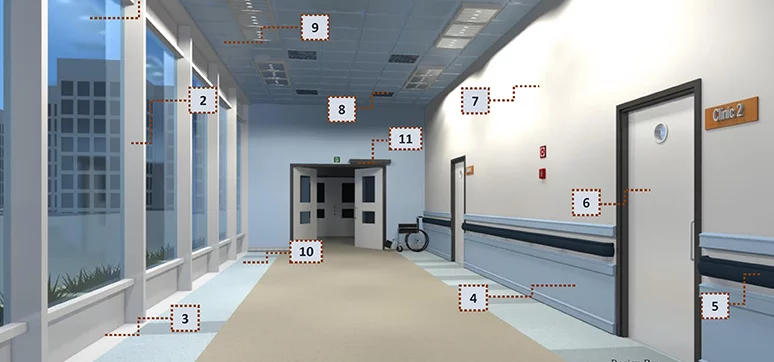The world is racing to discover a vaccine for COVID-19 to save mankind. Under the current circumstances, social distancing has become an integrated practice in our lifestyle. Globally, the emphasis is placed on a better hygienic atmosphere for both healthcare and non-healthcare buildings. Healthcare systems have been overwhelmed by a high rate of hospitalisation and quarantine measures. In fact, there has been a shift in building design perspective particularly related to healthcare facilities.
This necessitates reshaping the architecture and interior spaces to accommodate the new requirements dictated by the evolved regulations and standards post the pandemic. The pandemic has highlighted the importance of refining healthcare frameworks and proposing innovative tools to accommodate the rapid increase in patients. Therefore, it has become obvious that countries worldwide have to expand, upgrade, and retrofit existing healthcare facilities with an appropriate selection of façades and building design materials, such as cladding, flooring, and ceiling.

Healthcare-acquired infections (HAIs), caused by the transmission of pathogens from infected patients to other patients, visitors, and healthcare personnel have gained much attention. HAIs can extend hospitalisation stays and exert a tremendous economic burden on patients and healthcare systems. Within healthcare facilities, environmental contamination is often identified as a major contributor to the transfer of pathogenic HAI. Research has shown that HAIs are linked to the presence of patients, visitors, and medical personnel in the hospital environment.
Recently, the building biology term has been considered an essential element in façade design for both interior and exterior designed systems. Building biology: “the study of the holistic relationship between humans and their living and work environments”. It is committed to human health, environmental sustainability, and preventive building measures and focuses on a humane and ecological way of building that strives to strike a balance between humans, the built environment, and nature” [1]. Therefore, façade materials selection and building design are of paramount importance in maintaining a better-built environment through facilitating hygienic performance.
The integrated approach of façade design is concerned with building physics, architecture appearance, and aesthetic as well as the hygienic performance of material selection as shown in Figure 1. However, it is important to highlight that the design parameters of the façade might vary between the exterior and interior systems. Whereas the exterior system parameters depend on microclimate and building physics, the interior system is perceived as a functional unit. For instance, external walls affect its structure and physical properties whereas the interior wall meets the requirements of materials function and durability.
Ultimately, the exterior system performance entails several parameters such as heating, ventilation, air conditioning, and indoor air quality, amongst other parameters. The hygienic material selection for the internal system plays a pivotal role in controlling the acquired infection in hospitals. While the building physics design parameters could contribute to contamination prevention, appropriate material selection continues to have a pronounced effect on the health environment quality and infection prevention.
Internal Facade Design And Material Selection

Appropriate building material selection is essential in fulfilling the hygienic requirements of healthcare buildings. “Materials and finishes need to be robust and easy to maintain, as well as attractive. Well-selected, fit-for-purpose furnishings will complement a clear approach to design” [2]. Therefore, such selection should be made by certified healthcare architects to ensure performance adherence to international standards as shown in Figure 2. Inappropriate material selection could lead to the performance deviation of the entire building systems.
Healthcare experts opt for extensive disinfection of contact surfaces, equipment, and facilities which are fundamental in microbial prevention. Not doing so, can risk the spread of pathogens such as staphylococcus, aureus, and salmonella as they can survive on different surfaces for periods ranging from several hours to days and form a biofilm [3]. Bioaerosols have a natural tendency to adhere to surfaces by means of several mechanisms and may adopt their strategies for attachment according to the nature of surfaces.
Therefore, the most important parameters that should be taken into consideration when selecting the healthcare finishing materials are like the following:
- Topography of surfaces.
- Anti-adhesive surface.
- Place of use.
Topography Of Surfaces
In the medical environments, the “high touch” surfaces such as walls, door handle, and worktops are subjected to retain soil and/or micro-organisms which will impact on the cross infection control [4]. Therefore, the topography of the surface can influence the ration of growing micro-organisms and bacteria by the nano/micrometer design features of the surfaces. Modifying the Nano-structure feature of the materials can suppress microbes’ attachment in the way of increasing the spikes and reduce the flatness cross-area of microbe’s adherent on surfaces as shown in Figure 3.

In principle, surface smoothness plays a critical role in decreasing the microbe’s colonisation on surfaces, where the higher roughness, the greater the contact area resulting in a higher fouling rate. This depends on the protein feature comparing to the surface roughness. However, decreasing the forming of a microbe’s biofilm by using smooth surfaces can lead to the inactive state of microbes on surfaces without removing them. Enhancing the surface smoothness contributes further to microbial prevention [4].
Anti-Adhesive Surface
Forming a biofilm of bacteria appears when adsorption of proteins on the material surfaces is initiated.
Anti-adhesive features can lead to the following:
- Blocking of the transmission paths.
- Reduction of the adhesion force between microbes and solid surfaces before biofilm forming.
- Allowance of easy removal from the surfaces.
However, this mechanism can reduce the number of microbes’ attachment on surfaces and convert them to an inactive state without removing them. Therefore, hydrophobic (water-repellency) and super-hydrophobic surfaces which are characterised by water contact angle greater than 90º have shown the reduction of colony forming units (CFU) up to 80% of Staphylococcus aureus bacteria in some Nano-structured super hydrophobic surfaces such as (Silane coated polyacrylic acid) or Teflon coating as shown in Figure 4 [4]. In general, the greater molecules adhesion force of surfaces than the cohesion force of microbe’s attachment represents in anti-adhesive surfaces. Therefore, considering this parameter of the exterior or interior material selection of façade design can improve the hygienic quality and assist to reduce acquired infection.
Place Of Use

Within healthcare facilities, whether the use of surface materials is for exterior or interior purposes, there are a variety of factors to select proper materials. However, their performance to microbe’s growth varies as per the place of use and stain types. It is important to realise that cladding selection can be application-sensitive as what could be optimal for the operating room may not necessarily be appropriate for patient rooms use.
In addition, each material can be active against a range of specific strains of microbes. For example, Titanium Oxide (TiO2) Nano-particles have a high ability to prevent Gram-positive/ negative bacteria growth by induced their toxicity by visible light or ultraviolet. This position is to be an optimal selection in the presence of abundant light. On the other hand, Zinc oxide (ZnO) prevents the growth rate of various microorganisms such as MSSA (Methicillin-Resistant Staphylococcus). However, ZnO is known as UV blocking material, in which such a feature will be optimal to utilise as glass or fabric coating [5].
Conclusion
The proliferate of epidemics and the need for a hygienic atmosphere has been intensified by the recent COVID-19 pandemic, which has placed more emphasis on reshaping all aspects of design that have been taken for granted for a long time. Therefore, refining the material selection and placing appropriate emphasis on the key and underlying parameters of such selection will prove invaluable to the integrated performance of buildings.
References:
- Walter de Gruyter GmbH, Building biology, Criteria and architectural design, 2018, Retrieved from http://ebookcentral. proquest.com.
- Mike Kagioglou & Patricia Tzortzopoulos, Improving Healthcare through Built Environment Infrastructure, 2010.
- Patrizia Losito, Pierina Visciano*, Marisa Genualdo & et al. Evaluation of hygienic conditions of food contact surfaces in retail outlets: Six years of monitoring. 77 (2017) 67-71.
- C. Adlhart, J. Verran, N.F. Azevedo & et al. Surface modifications for antimicrobial effects in the healthcare setting: a critical overview. 99 (2018) 239-249.
- M. Abobakr, Design study of different façades for various zones of hospitals and rehabilitation resorts, 2017.














